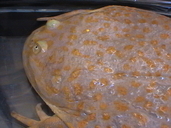|
Lepidobatrachus laevis Budgett, 1899
Budgett's Frog, Escuerzo de agua | family: Ceratophryidae genus: Lepidobatrachus |
 © 2006 Alberto Maceda Veiga (1 of 11) |
|
|
|
Description Distribution and Habitat Country distribution from AmphibiaWeb's database: Argentina, Bolivia, Paraguay
Within the chaco, L. laevis is found in ephemeral pools (pozos) that form during the summer rains from October to February. During the wet summer months these frogs feed and breed in the pozos. As the pools dry up at the end of summer the animals burrow into the soft mud using the large tubercles on their hind limbs. They remain inactive underground during the dry winter months. Life History, Abundance, Activity, and Special Behaviors Once the pools form L. laevis emerge from their cocoons to feed and breed. These frogs appear to be nocturnal sit-and-wait ambush predators. They remain motionless while submerged in the water or soft mud with only their eyes and nostrils visible. There they wait among grasses and reeds for prey to come within grasp of their strong, powerful jaws. The large size of these frogs and the size of their jaws imply that they feed on large prey, most likely other anurans, large insects and snails. In general these are very aggressive frogs. When disturbed, they inflate themselves and stand on their outstretched limbs to appear larger. If this fails to deter a potential predator, they begin to lunge, bite, and then emit a piercing shriek. This behavior is quite impressive and provides the name for this species in Guarani - kukurú-chiní or “the toad that shrieks” (Vellard 1948). The reproductive biology and larval ecology of L. laevis provide additional examples of the fascinating biology of this particular species of frog. A single breeding event may result in as many as 1400 fertile eggs. The embryos develop very rapidly, a characteristic of many desert anurans that often are in a race against time to metamorphose into adults before their breeding pool dries up. When the tadpoles hatch and begin feeding, however, their uniqueness becomes even more apparent. The tadpoles are carnivorous and cannibalistic and begin feeding almost immediately. Although carnivory and cannibalism are relatively rare among larval anurans, it is the morphology of the jaws of L. laevis tadpoles which sets them apart. Unlike other carnivorous anuran larvae, L. laevis possess nearly adult-like jaws. The cartilages that support the larval jaws are expanded laterally to create a wide, gaping mouth which the tadpoles of this species use to ingest their prey whole. Ruibal and Thomas (1988) illustrate this feeding apparatus in detail and coin the term “megalophagy” to describe the unique larval feeding ecology. Trends and Threats Possible reasons for amphibian decline General habitat alteration and loss
References
Aquino, L., De La Riva, I., and Céspedez, J. (2004). Lepidobatrachus laevis. In: IUCN 2009. IUCN Red List of Threatened Species. Version 2009.1. www.iucnredlist.org. Downloaded on 22 June 2009. Budgett, J. S. (1899). ''Notes on the batrachians of the Paraguayan chaco, with observations upon their breeding habits and development, especially with regard to Phyllomedusa hypochondrialis, Cope. Also a description of a new genus.'' The Quarterly Journal of Microscopical Science, 42(167), 305-333. Cei, J. M. (1980). ''Amphibians of Argentina.'' Monitore Zoologica Italiano, New Series Monografia, Firenze, 2, 1-609. Faivovich, J. (1994). ''La distribución del género Lepidobatrachus (Budgett, 1899) (Leptodactylidae: Ceratophryinae).'' Acta Zoologica Lilloana, 43(1), 137-174. Lavilla, E. O., and Cei, J. M. (2001). Amphibians of Argentina, A Second Update, 1987-2000. Museo Regionale di Scienze Naturali, Torino. Ruibal, R., and Thomas, E. (1988). ''The obligate carnivorous larvae of the frog Lepidobatrachus laevis (Leptodactylidae).'' Copeia, 1988(3), 591-604. Une, Y., Kadekaru, S., Tamukai, K., Goka, K., and Kuroki, T. (2008). ''First report of spontaneous chytridiomycosis in frogs in Asia .'' Diseases of Aquatic Organisms, 82, 157-160. Vellard, J. (1948). ''Batracios del chaco argentino.'' Acta Zoologica Lilloana, 5, 137-174. Originally submitted by: Carlos R. Infante (first posted 2003-03-24) Edited by: Kellie Whittaker (2009-06-22) Species Account Citation: AmphibiaWeb 2009 Lepidobatrachus laevis: Budgett's Frog <https://amphibiaweb.org/species/5602> University of California, Berkeley, CA, USA. Accessed May 24, 2025.
Feedback or comments about this page.
Citation: AmphibiaWeb. 2025. <https://amphibiaweb.org> University of California, Berkeley, CA, USA. Accessed 24 May 2025. AmphibiaWeb's policy on data use. |




 Map of Life
Map of Life